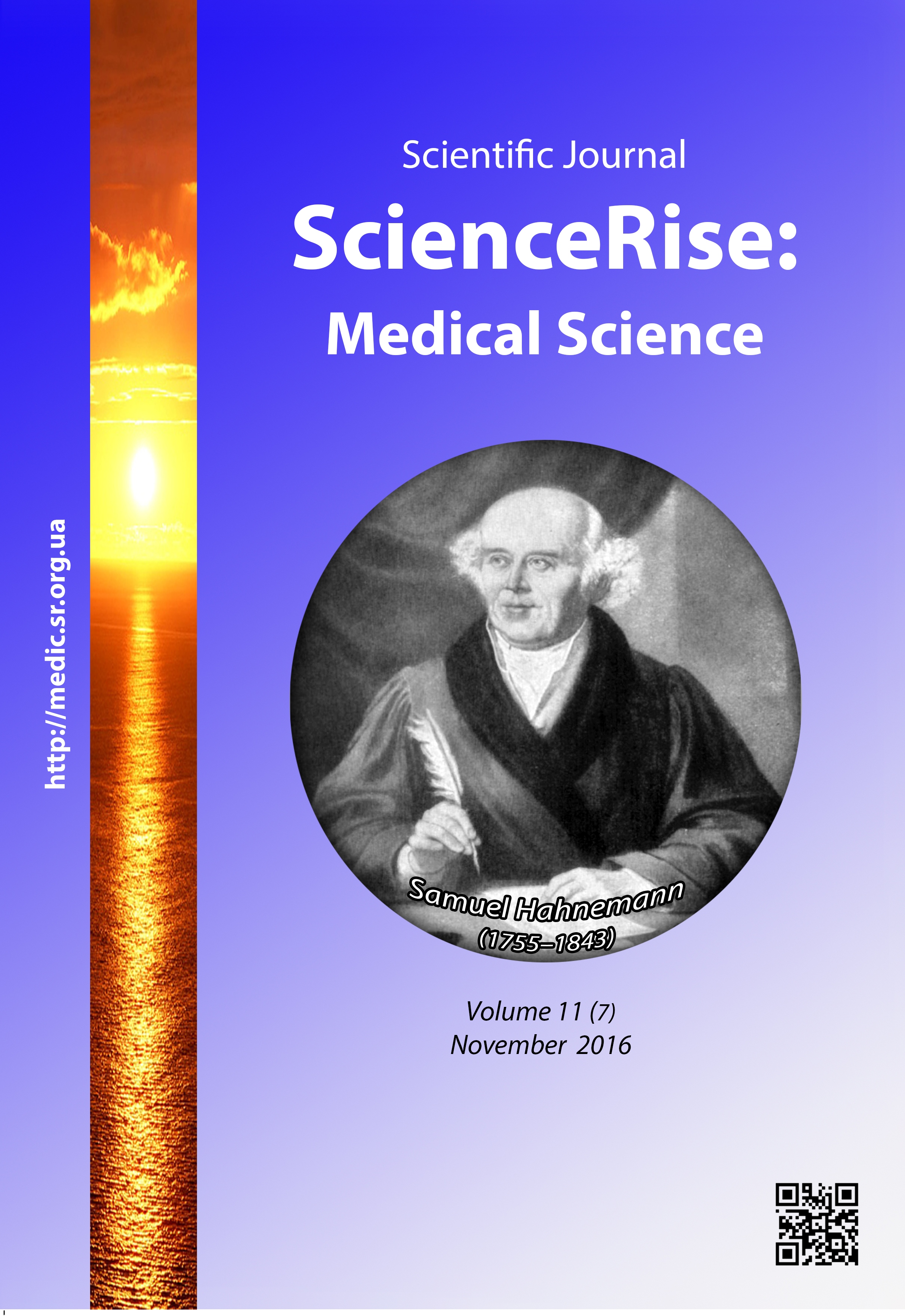The integrated assessment of the functional status of soccer players in different periods of football season
DOI:
https://doi.org/10.15587/2519-4798.2016.83997Keywords:
functional status, variational pulsometry, fazagraf, soccer, integral assessment, medical controlAbstract
The search for simple and minimally invasive methods of diagnostics of the functional status of professional soccer players was always the object of the interest of sport medicine and physiology.
The aim of research was the increase of medical control of the professional soccer players by elaboration and introduction of methodology of integral assessment of the soccer players’ functional status using the program-hardware complex Fazagraf®.
Methods of research. The research included 34 professional players in the age 18-34 years. The research was carried out during the football season in different training periods and included instrumental methodology of assessment of the functional status using apparatus fazagraf and also the methodology of assessment of the functional status, offered by us.
Results of research. With the help of the offered methodology it was established, that at the end of basic period the low marks of FS (1,2 and 3) were not fixed. All soccer players were in the good and very good FS. At the end of competitive period of training it was revealed, that in 11 soccer players (32%) were observed the low indices of integral assessment that is FS disorders.
Conclusion: in the basic period of training takes place the increase of adaptive potential and decrease of the risk of development of disorders in sportsmen’s health. In competitive period of training were observed the disorders of functional status under the effect of big physical loads and other factors that needs more attention to the medical control in this training period
References
- Solodkov, A. S. (2013). Osobennosti utomleniya i vosstanovleniya sportsmenov [Features of fatigue and restoration of the athletes]. Uchenyie zapiski universiteta imeni P. F. Lesgafta, 6 (100), 131–143.
- Mihalyuk, E. L., Sivolap, V. V. (2014). Sovremennyie vzglyadyi na diagnostiku metabolicheskoy kardiomiopatii vsledstvie hronicheskogo fizicheskogo perenapryazheniya organizma sportsmenov [Modern looks to diagnostics of metabolic cardiomyopathy caused by chronic physical overtraining of organism of sportsmen]. Sportivna meditsina, 1, 3–12.
- Castagna, C., Iellamo, F., Impellizzeri, F. M., Manzi, V. (2014). Validity and Reliability of the 45–15 Test for Aerobic Fitness in Young Soccer Players. International Journal of Sports Physiology and Performance, 9 (3), 525–531. doi: 10.1123/ijspp.2012-0165
- Iellamo, F., Pigozzi, F., Spataro, A., Lucini, D., Pagani, M. (2004). T-Wave and Heart Rate Variability Changes to Assess Training in World-Class Athletes. Medicine & Science in Sports & Exercise, 36 (8), 1342–1346. doi: 10.1249/01.mss.0000135796.75091.8°
- Kudrya, O. N. (2014). Otsenka funktsionalnogo sostoyaniya i fizicheskoy podgotovlennosti sportsmenov po pokazatelyam variabelnosti serdechnogo ritma [Estimation of the functional state and physical preparedness of sportsmen by the indexes of variableness of cardiac rhythm]. Vestnik Novosibirskogo gosudarstvennogo pedagogicheskogo universiteta, 1 (117), 185–196.
- Iordanskaya, F. A. (2010). Korrelyatsionnyiy analiz pokazateley adaptatsii s vozmozhnyimi faktorami riska serdechno-sosudistoy sistemyi pri obespechenii rabotosposobnosti u sportsmenov [Correlation analysis of indexes of adaptation with possible risk of the cardiovascular system factors at providing of capacity for sportsmen]. Vestnik sportivnoy nauki, 5, 25–30.
- Bashkireva, A. V., Chibisov, S. M., Halabi, G., Drogova, G. M., Eremina, I. Z., Harlickaja, E. V. (2011). Gendernye razlichiya biorytmologicheskych kharakteristic tsyrkadnogo ritma u sportsmenov parashutistov v period sorevnovaniy [Gender differences of biorhythmological characteristics of circadian rhythm in athletes parachutists during the competition]. Mezhdunarodnyj zhurnal prikladnyh i fundamental'nyh issledovanij, 8, 93–94.
- Dranitsin, O. V., Driukov, S. V. (2007). Rozrobka ta zastosuvannya metodiv zvukovogo zadavannya intensivnosti fizichnih navantazhen dlya funktsionalnoyi diagnostiki kvalifikovanih sportsmeniv [Design and application of sound signals in setting exercise intensity during physiological testing]. Moloda sportivna nauka Ukrayini. L'vіv: NVF “Ukrainian technologies", 11, 202–203.
- Antonov, A. A. (2013). Beznagruzochnaya otsenka funktsionalnogo sostoyaniyaorganizma sportsmenov [Loadless assessment of a functional condition of an organism of athletes]. Poliklinika, 1, 37–41.
- Faynzil'berg, L. S. (2013). Kompyuternaya diagnostika po fazovomu portretuelektrokardiogrammyi [Computer diagnostics by a phase portrait of the electrocardiogram]. Kyiv: Osvita Ukrainy, 191.
- Antomonov, M. U. (2006). Matematicheskaya obrabotka i analiz mediko-biologicheskih dannyih [Mathematical processing and analysis of medico-biological data]. Kyiv: Firma malogo druku, 558.
- Saaty, T. L. (1990). How to make a decision: The analytic hierarchy process. European Journal of Operational Research, 48 (1), 9–26. doi: 10.1016/0377-2217(90)90057-i
- Apanasenko, G. L. (2005). Izbrannyie stati o zdorovie [Selected articles about a health]. Kyiv, 48.
Downloads
Published
How to Cite
Issue
Section
License
Copyright (c) 2016 Павел Петрович Павличенко

This work is licensed under a Creative Commons Attribution 4.0 International License.
Our journal abides by the Creative Commons CC BY copyright rights and permissions for open access journals.
Authors, who are published in this journal, agree to the following conditions:
1. The authors reserve the right to authorship of the work and pass the first publication right of this work to the journal under the terms of a Creative Commons CC BY, which allows others to freely distribute the published research with the obligatory reference to the authors of the original work and the first publication of the work in this journal.
2. The authors have the right to conclude separate supplement agreements that relate to non-exclusive work distribution in the form in which it has been published by the journal (for example, to upload the work to the online storage of the journal or publish it as part of a monograph), provided that the reference to the first publication of the work in this journal is included.









